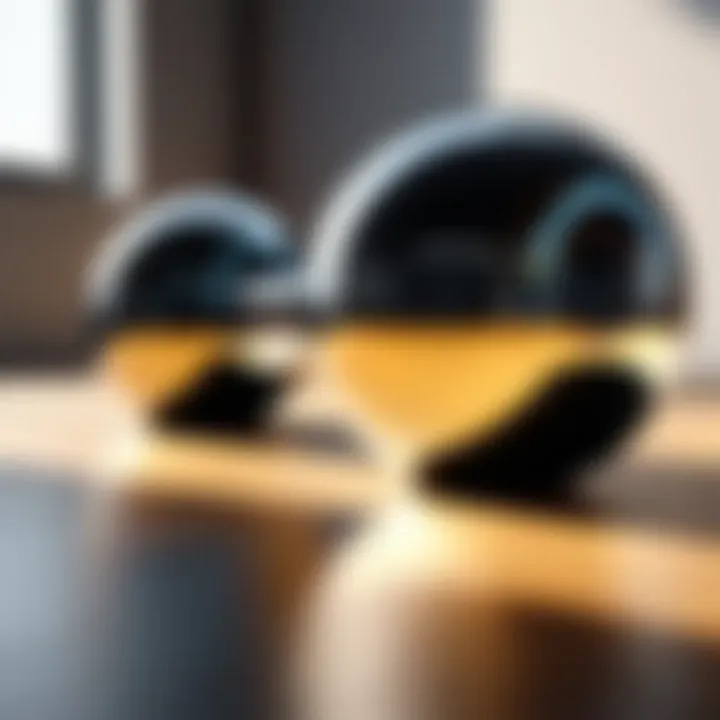Exploring Twinmotion's Path Tracing Technology


Intro
In today's digital landscape, the demand for high-quality visualizations is more critical than ever. This is especially true in fields like architecture and design, where immersive experiences can greatly influence decision-making. Twinmotion has emerged as a key player in this domain, offering robust path tracing capabilities that enhance rendering quality and efficiency. As we delve into the nuances of Twinmotion's path tracing technology, we'll explore its foundational principles, practical applications, and unique advantages.
Brief Description
Overview of the Software
Twinmotion is a real-time visualization software developed by Epic Games, designed to streamline the architectural visualization process. It allows users to create stunning visual experiences quickly. The software integrates with various design tools, enabling seamless workflows that cater to different stages of design and presentation. Path tracing, a sophisticated rendering method offered by Twinmotion, significantly elevates the realism and quality of visual outputs.
Key Features and Functionalities
Twinmotion stands out for several reasons:
- Real-time Rendering: Users can view changes instantly, facilitating a more interactive design process.
- Path Tracing: This rendering technique mimics how light behaves in the real world. It results in highly realistic lighting, shadows, and reflections.
- Intuitive Interface: The user-friendly interface makes it accessible for designers at all levels, reducing the learning curve.
- Rich Asset Library: Twinmotion includes a diverse library of objects, materials, and landscapes, allowing for quick customization of scenes.
- Output Options: Users can export images, videos, and VR experiences, enhancing the versatility of presentations.
System Requirements
Hardware Requirements
The efficiency of Twinmotion's capabilities, especially for path tracing, relies on adequate hardware. Key hardware specifications include:
- CPU: A multi-core processor is recommended for optimal performance.
- GPU: A dedicated graphics card is essential. NVIDIA or AMD with at least 4GB of VRAM is advisable.
- RAM: Minimum of 8GB; 16GB is recommended for large projects.
- Storage: SSDs are preferred for speed, with 20GB of free space required.
Software Compatibility
Twinmotion is compatible with various key operating systems, including:
- Windows 10 or later
- macOS Mojave (10.14) or later
Furthermore, Twinmotion offers integrations with other popular design software, such as Autodesk Revit, SketchUp, and ArchiCAD, enhancing its usability in professional environments.
As path tracing technology continues to evolve, professionals using Twinmotion can expect improved rendering capabilities and efficiency, ensuring elevated quality in their visual presentations.
It aims to equip IT professionals, software developers, and architectural designers with the knowledge necessary to utilize Twinmotion effectively in their projects.
Preface to Twinmotion
Understanding Twinmotion is essential for anyone looking to create high-quality visualizations efficiently. Twinmotion is a real-time 3D visualization software that bridges the gap between technical modeling and artistic rendering. This tool provides professionals in architecture, urban planning, and product design with a way to present their ideas vividly and persuasively.
Overview of Twinmotion Software
Twinmotion offers a user-friendly platform that integrates seamlessly with many 3D modeling programs. Its interface is designed to allow users to navigate through their projects easily, facilitating quick edits and real-time changes. The software is built on powerful rendering capabilities that enhance the visual impact of any design project.
One standout feature of Twinmotion is its ability to leverage high-quality, photorealistic rendering without extensive training. Users can create narratives around their designs, engaging stakeholders by showcasing realistic environments and atmospheric conditions. This enables architects and designers to visualize their ideas before execution.
Importance of Real-Time Rendering
The concept of real-time rendering has transformed how professionals present their work. With Twinmotion, users can see changes immediately as they modify their designs. This immediacy fosters creativity and efficiency, as feedback can be integrated spontaneously, streamlining workflow.
Real-time rendering enhances collaboration among team members, as everyone can view and discuss modifications in real time. This is particularly relevant in fields where visual clarity is crucial for decision-making.
- Key benefits of real-time rendering include:
- Immediate visualization of design changes
- Enhanced collaboration through live feedback
- Faster decision-making for clients and teams
Twinmotion’s role as a real-time rendering tool makes it indispensable in contemporary design workflows, ensuring that professionals can deliver high-quality visuals while maintaining agility in their projects. Through understanding these foundational aspects of Twinmotion, readers can appreciate its capabilities and integrate them into their workflows effectively.
Understanding Path Tracing


In the domain of computer graphics, the concept of path tracing holds significant relevance. This rendering technique is essential for achieving high-quality visualizations. In the context of Twinmotion, understanding path tracing is crucial for maximizing the software's capabilities. This knowledge not only enhances the visual fidelity but also improves the overall user experience, making it a vital aspect for IT and software professionals.
What is Path Tracing?
Path tracing is a rendering method that simulates the way light interacts with surfaces. Unlike traditional rendering techniques, path tracing calculates the paths that rays of light take as they bounce around a scene. Each ray traces a path from the camera to light sources, capturing how light reflects and refracts off surfaces. This process results in more realistic images, as it can accurately represent complex lighting scenarios, such as soft shadows and caustics.
The principles of path tracing are rooted in physics, particularly in how light behaves in the real world. Each ray of light is treated as a particle that travels through space, interacting with surfaces according to the laws of reflection and refraction. Path tracing produces images that closely resemble real-world scenarios, making it particularly beneficial for visualizations in architecture, design, and marketing campaigns.
Technical Mechanism of Path Tracing
The technical mechanism of path tracing involves several steps that contribute to its efficacy in producing highly realistic images.
- Ray Generation: The process begins with the generation of rays from the camera. These rays extend into the scene, representing the viewer's perspective.
- Surface Interaction: When a ray intersects a surface, the renderer calculates how the light interacts with the material properties of that surface. This involves parameters like color, texture, and reflectivity.
- Light Sampling: For each surface intersection, the renderer samples light from various light sources in the scene. This step is crucial for determining how much light reaches the surface point from different directions.
- Bouncing Rays: After interaction with a surface, rays can continue to bounce off. Each bounce is traced recursively, capturing indirect light and enhancing the final image's depth.
- Color Calculation: Finally, the renderer integrates all the light contributions to determine the color of the pixel.
The iterative nature of this process can require extensive computational resources and time. Consequently, resource management becomes significant when using path tracing, especially in applications like Twinmotion where rendering quality is paramount.
"Path tracing is an essential tool in achieving photorealism. It allows designers and architects to visualize their projects in a way that closely mirrors reality."
By understanding these technical aspects, IT and software professionals can better grasp the importance of path tracing and its implications for rendering quality in Twinmotion. This knowledge not only helps in optimizing workflows but also guides efficient use of the software's features, leading to more impactful visual presentations.
Path Tracing in Twinmotion
The inclusion of path tracing in Twinmotion marks a significant advancement in rendering capabilities. This feature allows users to achieve a higher level of realism in their visualizations, setting apart Twinmotion from other tools in the market. Path tracing is more than just a technical upgrade; it's a paradigm shift in how designers and architects visualize their concepts and present their ideas. By accurately simulating the way light interacts with surfaces, Twinmotion provides users with stunningly realistic outputs that significantly enhance the quality of their renderings.
Activation of Path Tracing Feature
Activating the path tracing feature in Twinmotion is a straightforward process. Users need to navigate the settings panel where they can enable path tracing. This activation allows for options such as adjusting light and shadow settings. It is critical to follow the right sequence to ensure that all visual components work effectively together. The option may be found under rendering settings, simplifying the user experience. Once activated, users can appreciate the instant visual upgrades that path tracing offers.
- Steps to activate path tracing:
- Open Twinmotion.
- Click on the 'Settings' icon.
- Navigate to the 'Rendering' tab.
- Enable the 'Path Tracing' option.
After enabling path tracing, it is good to experiment with additional settings to optimize the rendering according to specific project needs. This flexibility allows users to achieve the desired aesthetic while maintaining performance efficiency.
User Interface Considerations
The user interface of Twinmotion accommodates the path tracing feature with simplicity and clarity. The layout presents the path tracing options intuitively, making it accessible even for less experienced users. Icons and sliders allow quick adjustments without overwhelming the user. Focused sections highlight critical features like lighting and rendering quality.
Moreover, Twinmotion offers real-time feedback while using path tracing. Users can see changes as they adjust settings, which enhances the overall experience. This immediacy aids in decision-making throughout the design process, making it easier to achieve specific goals.
“The integration of path tracing into the user interface allows designers to focus more on creativity and less on technical constraints.”
Benefits of Path Tracing in Rendering
Path tracing offers significant advantages in rendering practices, especially within Twinmotion. The merits of employing path tracing techniques cannot be overstated. They improve visual realism, enhance the interaction of light, and refine material representation. These benefits are not just incremental; they can translate into substantial improvements in design presentations.
Enhanced Visual Fidelity
One core advantage of path tracing is its potential for enhanced visual fidelity. Unlike traditional rendering techniques, which may rely on approximation, path tracing simulates light interactions in a more accurate manner. This simulation results in imagery that better reflects how light behaves in the real world. For example, shadows are more natural, soft gradations are smoother, and reflections become clearer.
In environments where accuracy is crucial, such as architectural visualizations, the realistic outputs can help clients perceive designs in ways that matter most.
With enhanced visual fidelity, designers can also present ideas with appropriate context, making them more persuasive. Visuals produced through path tracing attract attention due to their striking realism, thus serving as effective tools for communication in various industries.
Realistic Light Interaction
Path tracing excels in depicting realistic light interaction. Traditional rendering methods often struggle with complex lighting scenarios. However, path tracing models these interactions through a comprehensive approach. Lights interact with surfaces based on their properties and surroundings, accounting for scattering, absorption, and reflection.
This ability to replicate real-world lighting conditions means that designers using Twinmotion can display their projects under different lighting scenarios. They can simulate daytime sunlight, nighttime conditions, or artificial light sources with accuracy. This versatility is invaluable in sectors such as architectural design, where lighting plays a key role in aesthetic appreciation and functional usability.
"Realistic light interaction facilitated by path tracing provides a nuanced understanding of spatial design, enhancing overall project visibility."


Improved Material Representation
Another critical benefit of path tracing is improved material representation. The way materials are rendered can significantly affect the perception of a design. Path tracing allows for precise modeling of various materials, capturing their unique characteristics. Metallic surfaces exhibit reflections, and textiles display texture variations that are almost indistinguishable from actual materials.
With Twinmotion's path tracing capabilities, professionals can render wood, glass, and fabric with remarkable authenticity. This accuracy creates not just aesthetically appealing visuals but also practical insights for project assessments. Clients can visualize how materials interact in their intended environments, ensuring that choices are informed.
Applications of Path Tracing in Various Fields
The applications of path tracing are vast, offering benefits across several industries. As this article explores, understanding the practical implications of Twinmotion’s path tracing can help professionals leverage technology for optimal results in their work. This section delves into key areas where path tracing shines, highlighting its relevance and impact.
Architectural Visualization
Path tracing in architectural visualization changes how professionals present designs. This rendering technique produces realism that enhances client understanding and engagement. It accurately simulates light behavior, creating lifelike shadows and material properties. This level of detail is particularly beneficial for architects, as it aids in decision-making and feedback gathering.
Benefits of using path tracing in architectural visualization include:
- Realistic Representation: Renderings look nearly identical to real life, making it easier for stakeholders to visualize the final product.
- Improved Client Communication: Clients often visualize abstract designs poorly. Realistic images bridge that gap, allowing clearer discussions.
- Facilitated Design Revisions: Fast feedback loops lead to improved designs that more closely align with client expectations.
This realism fosters trust and satisfaction in clients, ultimately contributing to a smoother design process.
Urban Planning
In urban planning, path tracing offers innovative solutions for presenting large-scale projects. By visualizing entire city environments, planners can assess the impact of design choices effectively. The technique allows for dynamic light simulation, showing how urban spaces would look during different times of day.
Key aspects of path tracing in urban planning include:
- Day-Night Cycle Visualization: Path tracing enables planners to visualize how shadows and light interact within the urban space over different times, aiding in designing effective public areas.
- Enhanced Environmental Impact Assessment: Planners can consider how proposed developments fit within the existing environment, promoting sustainable design choices.
- Community Engagement: Realistic visualizations can help engage the public in discussions about new projects, ensuring their voices are heard.
By utilizing path tracing, urban planners create informed, interactive, and engaging presentations for stakeholders and communities alike.
Product Design and Marketing
Path tracing is also vital in product design and marketing strategies. It allows companies to present prototypes accurately before production, saving resources and time. The ability to showcase textures, colors, and materials effectively leads to more convincing marketing materials.
Advantages of using path tracing in product design and marketing include:
- Visual Precision: Accurate renders translate well into advertisements and prototypes, resulting in an appealing presentation.
- Realistic Material Representation: It showcases how materials interact with light, making product features more prominent to prospective buyers.
- Rapid Prototyping: Designers can create and showcase virtual prototypes, reducing the need for physical samples.
Thus, companies using Twinmotion's path tracing can enhance their market position while achieving design clarity.
Path tracing transforms the way various fields approach visualization, enabling professionals to convey ideas and designs with striking realism and accuracy.
Comparative Analysis of Rendering Techniques
Rendering techniques play a crucial role in the final output of visualizations in various fields such as architecture, animation, and product design. The ability to choose the right rendering method can significantly influence the quality of the images and the efficiency of the workflow. Understanding different rendering techniques, especially rasterization and path tracing, allows professionals to make informed decisions that align with project goals. This analysis emphasizes the strengths and weaknesses of each method while considering hybrid approaches that offer a balance between performance and visual fidelity.
Rasterization vs. Path Tracing
Rasterization is a widely used rendering technique that converts vector graphics into pixels. This process is typically faster, making it suitable for real-time rendering scenarios. However, rasterization has limitations in simulating realistic lighting, shadows, and reflections. It primarily relies on precomputed lighting methods, which can lead to less accurate representations of materials and environments.
Key Aspects of Rasterization:
- Speed: Rasterization quickly processes images, which benefits interactive applications, like video games.
- Simplicity: The method is straightforward, making it easier to implement in various engines and platforms.
- Performance: For non-realistic and stylized outputs, rasterization provides efficient results without heavy computational demands.
In contrast, path tracing offers a more realistic approach. It simulates how light interacts with surfaces, resulting in sophisticated light behavior that reflects materials much more accurately. While it produces visually stunning images, the trade-off is significantly longer rendering times. In scenarios where realism is paramount, the detailed output from path tracing can be invaluable.
Key Aspects of Path Tracing:
- Realism: This method captures complex lighting effects like caustics and soft shadows, offering a lifelike quality to scenes.
- Quality: Path tracing yields superior results in scenes with dynamic lighting and reflective materials.
- Complexity: Implementing path tracing can be resource-intensive, requiring powerful hardware to facilitate rendering without long wait times.
Benefits of Hybrid Rendering Approaches


Hybrid rendering approaches aim to combine the advantages of both rasterization and path tracing. By leveraging the speed of rasterization for initial passes and utilizing path tracing for final touches or specific elements, users can achieve a satisfactory balance. This can be especially beneficial for real-time applications where immediate feedback is essential but realism is equally important.
Benefits Include:
- Efficiency: Achieving quick renders while retaining elements of realism helps maintain workflow productivity.
- Flexibility: Users can adapt their rendering strategy based on specific project requirements or client needs.
- Cost-Effectiveness: Utilizing a hybrid approach can reduce the need for extensive computational resources without sacrificing output quality.
"Choosing a rendering technique is not just about the final picture. It's about being strategic in how you allocate your resources and time."
Challenges and Limitations of Path Tracing
Path tracing in Twinmotion offers impressive visual outcomes but has its own set of challenges. Engaging with these limitations is essential for users aiming to optimize their workflows and enhance their project outcomes. The discussion centers on two primary factors: Rendering Time Constraints and Resource Demands of Path Tracing.
Rendering Time Constraints
One significant challenge in utilizing path tracing is the rendering time. This technique typically requires more computation than traditional rendering methods like rasterization. The reason for this is the way light interacts with surfaces in the virtual environment. Each ray traced must calculate how light bounces off different materials, which can quickly increase processing time.
Users often find themselves waiting longer for a final image, particularly in complex scenes with intricate lighting setups. This suggests that path tracing is not always suitable for real-time applications or projects with tight deadlines. The acceptable amount of rendering time can vary based on the project requirements. For instance, architectural firms might prioritize image quality over speed for key presentations, whereas product designers may need quicker turnaround times for iterative processes.
To mitigate this issue, users can adjust settings in Twinmotion to lower the rendering quality or adapt their scenes to minimize complexity. Balancing quality and speed can be difficult, but awareness of rendering constraints is the first step in managing expectations.
Resource Demands of Path Tracing
The second hurdle is the resource demands that come with path tracing. This rendering method requires substantial computational power. High-performance graphics cards and processors are often necessary to achieve satisfactory results within a reasonable timeframe. For businesses that rely on high-quality visual outputs, the investment in hardware becomes critical.
The hardware limitations can affect both small studios and larger enterprises. Smaller teams may not have the financial flexibility to upgrade equipment regularly, complicating their workflow with potential bottlenecks. Meanwhile, larger companies must consider the return on investment when deciding to upgrade their infrastructure for path tracing purposes.
In summary, while path tracing enhances the realism of visualizations in Twinmotion, the issues surrounding rendering time and hardware demands cannot be overlooked. Users must navigate these limitations to fully leverage path tracing's advantages in their projects.
"Being aware of the demands of path tracing can turn limitations into informed decisions for better project outcomes."
The Future of Path Tracing in Visualization Software
As the digital landscape evolves, the focus on rendering techniques grows tremendously significant. Path tracing has emerged as a breakthrough, offering realism that enhances visual experiences across various sectors. In the context of Twinmotion, understanding its future implications is critical for professionals in design and architecture. The trajectory of path tracing technology will influence not only rendering quality but also workflows and user experiences in various applications.
The future of path tracing in visualization software like Twinmotion holds great promise. By anticipating developments in this area, designers can better integrate new techniques into their projects. Emphasis lies on several key elements:
- Improved rendering processes
- Enhanced visual outputs
- Integration into real-time applications
With the continued growth in computational power and advancements in algorithms, real-time path tracing is likely to become the standard in rendering. The need for faster processing times will push innovations that optimize performance while preserving quality. As a result, we can expect software to support increasingly complex environments without significant lags.
Trends in Real-Time Path Tracing Technology
Several trends come to light as the future of path tracing unfolds. First, real-time capabilities are expanding rapidly. These advancements will allow designers to visualize projects at unprecedented speeds.
Some notable trends include:
- AI-based optimization - Coupling artificial intelligence with path tracing will streamline resource management, making it easier to achieve quality results without lengthy render times.
- Cloud computing integration - Offloading computational demands to the cloud can enhance rendering flexibility and accessibility. This means that even less powerful hardware can successfully handle complex visualizations.
- User interface evolution - As these technologies advance, their interfaces become increasingly user-friendly. This trend facilitates ease of use for professionals who may not have extensive technical backgrounds.
"With the advancements in real-time path tracing, the gap between design conception and visualization is narrowing dramatically."
Potential Developments in Twinmotion
Twinmotion, specifically, is poised to benefit from these trends significantly. Potential developments within the software are likely to focus on:
- Enhanced path tracing features - Future versions may include more sophisticated algorithms, enabling more accurate light and shadow simulations.
- Broader integration with other design tools - Ongoing compatibility with leading software such as Revit or SketchUp will simplify cross-software workflows.
- User-driven customization - As user feedback becomes more integral to development, tailored capabilities specific to diverse industries will emerge.
Ending
The conclusion of this article encapsulates the significance of path tracing technology within Twinmotion, reinforcing its value to a variety of industries. The exploration of this technology is not merely academic; it holds real-world implications for professionals who seek to optimize their workflows and enhance their design outputs.
Summary of Insights
The insights derived from the comprehensive examination of Twinmotion's path tracing capabilities highlight several pivotal elements. Firstly, path tracing offers enhanced realism and detail in rendering, significantly improving the visual quality of presentations. This technology effectively simulates natural light conditions, allowing users to create more immersive environments. Secondly, as evident from the discussions on its applications, path tracing stands out in sectors such as architecture, urban planning, and product design. Its ability to represent materials and light interactions realistically is a turning point for professionals aiming to communicate their visions effectively. Lastly, the challenges associated with path tracing, such as its resource intensity, are tempered by its advantages. Understanding these factors helps users align their expectations and prepare their systems adequately to leverage Twinmotion's full potential.
Final Thoughts on Path Tracing in Twinmotion
As we look to the future of path tracing in visualization software, it is clear that this technology will become increasingly essential. The trajectories in real-time rendering technology suggest rapid advancements that will likely enhance the efficiency of path tracing processes. Considering Twinmotion's ongoing developments, it is reasonable to expect future updates to focus on balancing quality with performance, addressing the current limitations noted in this article. For IT professionals and designers, staying abreast of these developments will be critical. They must adapt to the evolving landscape to remain competitive and innovative in their respective fields. Investing time into understanding path tracing technology, especially within platforms like Twinmotion, can yield substantial returns in the quality of work produced and the effectiveness of design communication.
"In the realm of design, the intersection of technology and creativity shapes the future of visualization."



